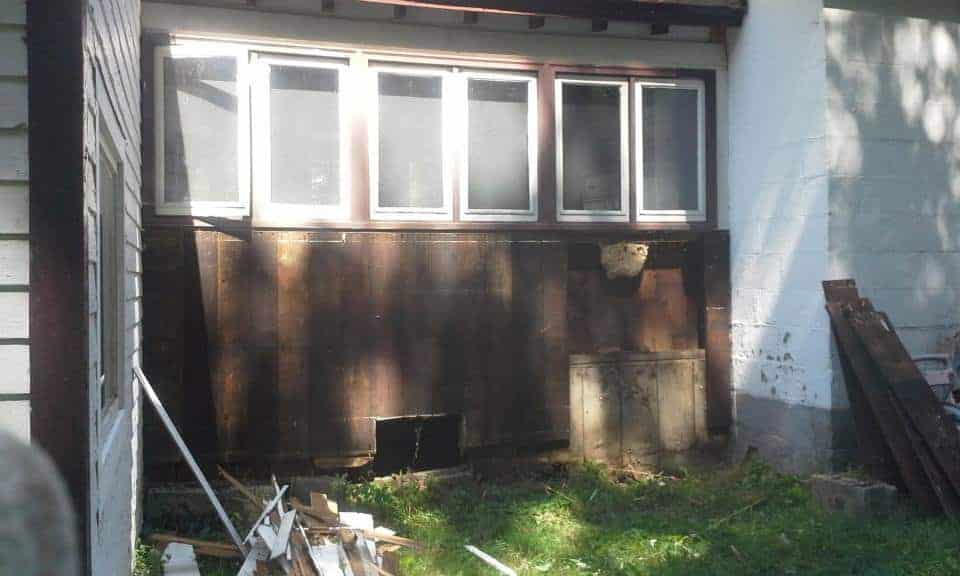It all started when I decided to paint my bedroom. I know, my bedroom is inside and the bees are outside, but that is how it all began, at least for me. For the bees, it began in Tennessee, but I’ll explain that later.
Projects like painting are far more fun with a friend, so I asked a friend of mine to help me out. In between coats, we went outside to get some air and decided to look in on the bees. For the umpteenth time that season, I opened the shutter and looked in the window at the hive. This time, instead of just an unexplainable gut feeling that something was wrong, I saw a nearly bee-less hive. And the bees I did see didn’t look right. Too big, and not yellow enough.
As we turned to face the house while mulling over the evident hive problem, my friend noticed bee-like insects flying in and out of the siding of my house. In my desperation for an answer to what was going on, and slightly high on paint fumes, I determined that the bees must’ve made their own nest inside the wall of the house and something else moved in. I decided then and there that I would have to pull off the siding (which was fine since I’d been wanting to put up vinyl anyway) and rehome the bees.
The following weekend, a non-beekeeper friend of mine who was interested in learning more about bees agreed to assist me with the re-homing and re-siding project. To begin, I had to make sure the hive was cleaned out and ready for them. Thinking that all the bees had absconded, I far too quickly opened it without bee gear. Big mistake.
Out of the wide-open hive came extremely large, intensely angry bees. I got stung – the most painful stung I’ve ever felt. With a shriek, I started to run away from the hive. Honeybees will not follow. These bees, however, chased me around the entire yard stinging if they caught me. With each sting, I cried out in pain and the people moving into the house next-door thought they’d bought the house next to the crazy lady. Eventually, I got in the house, donned bee gear, and finished killing the invader bees. My vegan heart broke, but I really didn’t see any other choice.
Since I was feeling woozy from the be stings and my friend was both interested and willing we got him dolled up in the bee gear and he went to work pulling off the old siding while the insects swarmed around him. When he reached the hive, I gave him instruction on how to cut the comb off the beam it had been built on and catch it a box and then dump it in the hive. As I was inside the house directing through a window, I didn’t see the comb nor did I hear it fall in the box. I did see the transfer from box to hive. Admittedly, something struck me as off, but I couldn’t quite figure out what.
As I was waking up the following morning, it finally hit me. The “comb” I saw falling into the hive was gray, not white, and was too solid to be wax. Muttering curse words, I went out to the hive and peeked in the window. I was hoping to see bees busily at work cleaning up comb and honey, but no. I was so very wrong.

Instead, I saw a paper hive with yellow jackets flying around quite happily. Much cursing and swearing ensued. Still woozy from the bee stings the day before, I elected to wait until my friend arrived to help with finishing the siding before dealing with the yellow jackets. I explained the situation to him, and he, once again, donned the bee gear and tipped the hive. After a time, he’d rid the yard of the yellow jackets while inside the house, I cried for so much death and destruction. That year, I had no bees to even think about prepping for winter. It was late summer and I had no bees and no time for new ones to establish themselves enough to survive the winter.
Sad and disappointed, I needed to figure out what happened. Several Benadryl and a few days later, I finally felt well enough to think clearly. What I realized was that these bees were not local. They were from Tennessee. It’s much warmer there and it was likely that the bees had become partially Africanized.
When I’d first put them in the hive I’d noticed two queens during a hive inspection. This is rare, we think, but a small percentage of honeybee hives do thrive with two queens, so I figured I was lucky and didn’t think much more about it. After this incident, I hypothesized that one of the queens was a less docile breed, possibly part African and as the season wore on the more violent genetic material overtook the hive.
Admittedly, I didn’t do as many hive checks as I should have. However, other than catching this violent change sooner, there wouldn’t have been a lot I could have done anyway. Also, this theory assuaged my guilt a bit as the Africanized bees wouldn’t have survived the winter. Despite that selfish benefit, I do think it’s the correct assumption. Which led me to believe that I needed to find a more local source for bees.
As of now, I’m still searching for the source. After all the trauma, death, and destruction of that year, I needed a season off to recover and rethink. I had to take some time to remember what it is I love about beekeeping and come to terms with causing the death of so many insects. I’m ready now. And more knowledgeable than when I started.
